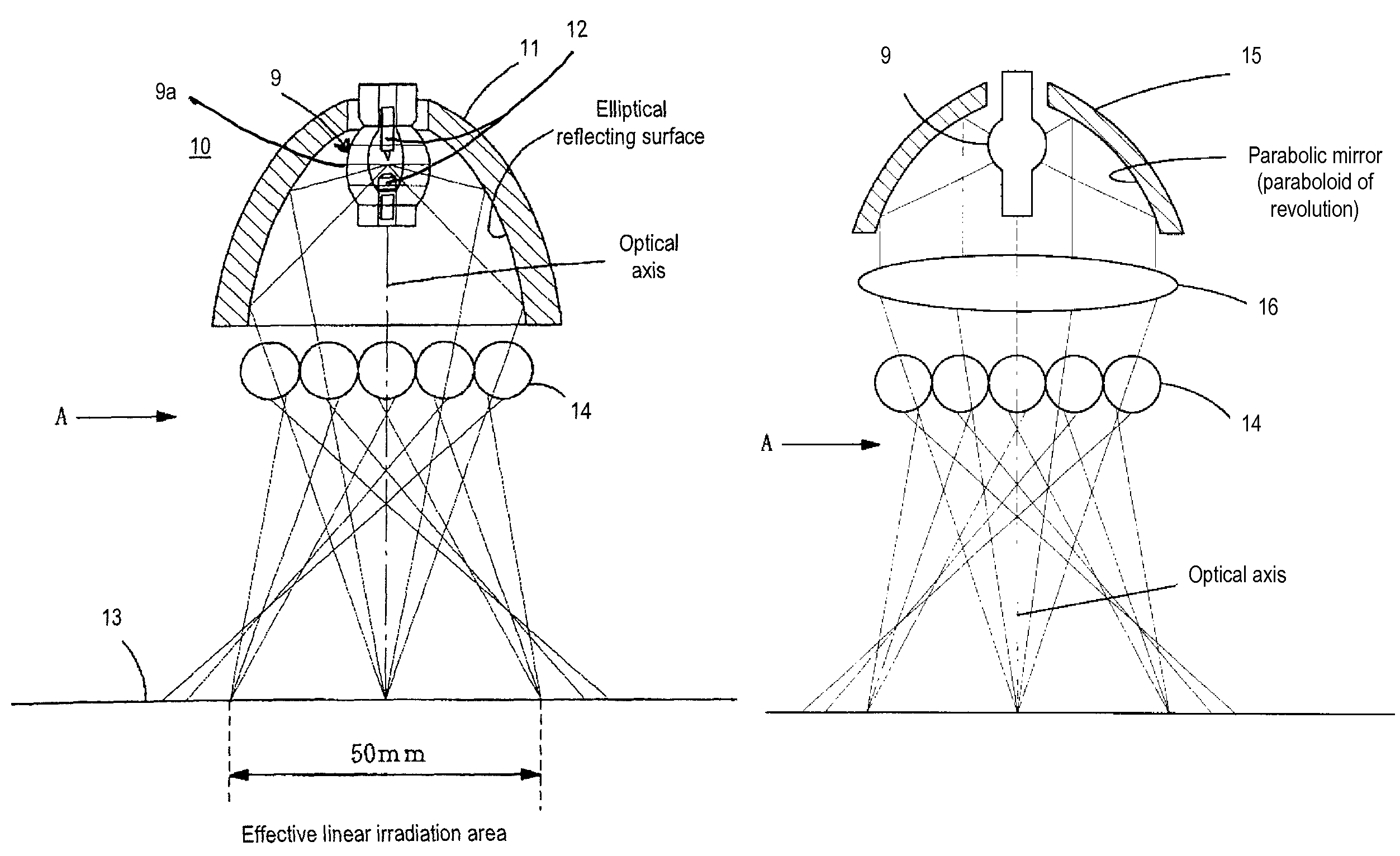Light irradiation device and inkjet printer
a technology of light irradiation and inkjet printer, which is applied in the direction of printing, point-like light sources, light sources, etc., can solve the problems of high temperature of substrate, difficult to further increase the radiance of long-arc lamps, and high temperature of substrates, so as to achieve strong light irradiation regions, regulate length, and high irradiance
- Summary
- Abstract
- Description
- Claims
- Application Information
AI Technical Summary
Benefits of technology
Problems solved by technology
Method used
Image
Examples
first embodiment
Variation of First Embodiment
[0090]Now, in this embodiment, a reflector with a reflective surface in the shape of an ellipsoid of revolution is used as the means of focusing the light emitted from the lamp, but it is possible to replace this, as shown in FIGS. 3(a) &3(b), with a reflector 15 having a reflective surface in the shape of a paraboloid of revolution and a convex lens 16 on the light-emission side of the reflector 15. FIG. 3(a) is a diagram as seen from the radial direction of the rod lenses; FIG. 3(b) is a diagram as seen from the direction A in FIG. 3(a).
[0091]In FIG. 3, the reflector 15 is constituted by a parabolic mirror of which the reflective surface is a paraboloid of revolution centered on the beam axis, and the light-emitting portion (spot of the arc) of a short-arc type discharge lamp 9 is positioned at the its focal point.
[0092]The light from this discharge lamp 9 is reflected by the reflector 15 that surrounds the lamp 9, and gives collimated light. A convex ...
second embodiment
[0106]FIG. 6 is a diagram showing the second embodiment of this invention, which is constituted to obtain a longer linear light irradiation region. In FIG. 6, two of the light sources 10 shown in FIG. 1 are used in order to provide a long, linear light irradiation region, but it is also possible to use two of the light irradiation devices shown in FIG. 3.
[0107]In FIG. 6, the light sources 101, 102 have the same configuration as the light source 10 shown in FIG. 1: a straight line connecting the pair of electrodes on an extension of the optical axis of the reflector 11, and the reflector 11 has a reflective surface that is an ellipsoid of revolution centered on that optical axis, with the light-emitting part of the discharge lamp 9 (the spot of the arc, for example) positioned at the first focal point of the reflector 11 that has a reflective surface that is an ellipsoid of revolution.
[0108]In the light sources 101, 102, light from the discharge lamp 9 is reflected by the reflector 1...
third embodiment
[0119]FIGS. 8(a)-8(c) are diagrams showing the third embodiment of the invention. This embodiment has reflecting mirrors 17 arranged parallel to the axial direction of the rod lenses 14 (lengthwise), i.e., on both sides of the rod lenses 14 in the embodiment shown in FIG. 1.
[0120]Of the light incident in the rod lenses 14, the light that is perpendicular to the axial direction (lengthwise) is spread by the rod lenses 14 after it is focused, as stated previously. For that reason, the irradiance peak of the light emitted from each rod lens 14 shifts and the light overlaps on the light irradiation surface; the irradiance distribution becomes uniform, but there is a irradiance distribution with higher irradiance at the center and lower irradiance at the edges.
[0121]In this embodiment, therefore, there are reflecting mirrors 17 on both sides of the light-emission side of multiple rod lenses 14, to reflect the spreading light in the direction perpendicular to the axial direction of the ro...
PUM
 Login to View More
Login to View More Abstract
Description
Claims
Application Information
 Login to View More
Login to View More - R&D
- Intellectual Property
- Life Sciences
- Materials
- Tech Scout
- Unparalleled Data Quality
- Higher Quality Content
- 60% Fewer Hallucinations
Browse by: Latest US Patents, China's latest patents, Technical Efficacy Thesaurus, Application Domain, Technology Topic, Popular Technical Reports.
© 2025 PatSnap. All rights reserved.Legal|Privacy policy|Modern Slavery Act Transparency Statement|Sitemap|About US| Contact US: help@patsnap.com



